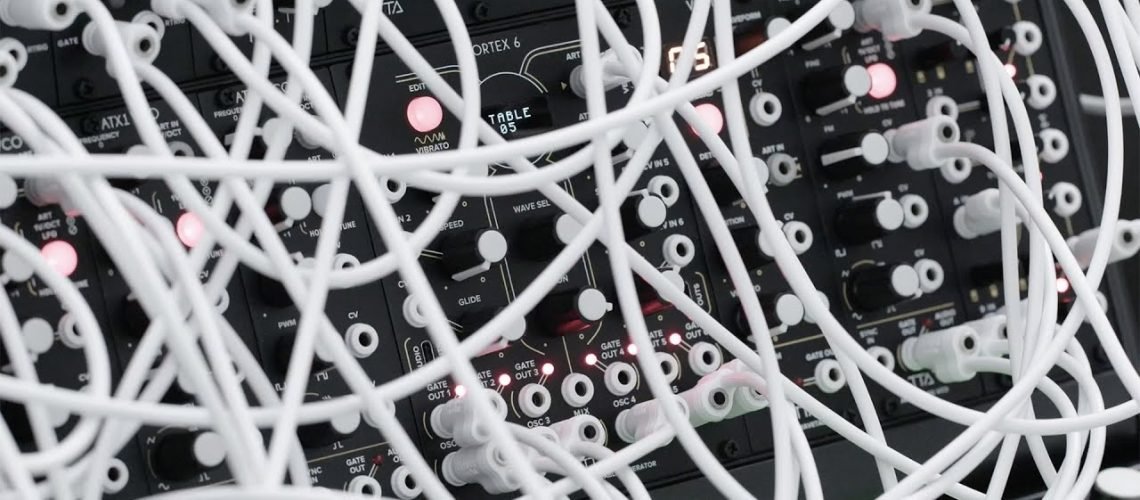Imagine polyphonic modular patches – but now imagine that with polyphonic patch cables. Announced in May, Tiptop Audio’s ART system and patching approach arrives now as modules, a system, and a whole mess of videos exploring patching with this paradigm for polyphony and integrated expressive data, all via analog connections.
And good news – an entire system can be had for under a grand, meaning this might not be a bad way to get started with modular. I expected something wildly expensive; maybe because I was blinded by those gorgeous white cables atop the sleek black modules.
For a review of the concept, you can flash backward in time to the announcement video back in sunny May of last year at Superbooth:
But in short, this is a scheme to expand what’s possible with Eurorack – building on the audio and CV patching you already have. ART is a new control signal scheme. Analogous to the 1v/octave pitch connections and other CV with different scales you have in a system (or even MIDI minijack connections and whatnot), this is another signal layer for patching. It’s still an analog connection – but in another first, you get all-analog Polytip patch cables that use USB-C connector types. From the FAQ:
ART control has precise pitch information as well as performance data about the note (velocity, mod and pressure). The ART signal is high speed for near zero latency and an analog ‘feel’. ART is also much cheaper to implement compared to the old quantized voltage based analog method.
And yes, your modules and analog-connected gear will work – you’ll just need ART to handle sequencing outside the standard 1v/octave scheme:
All of your filters, envelopes, LFOs, VCAs, effects, signal processors, mixers , patch cables will work with the ART modules. 1V/oct based sequencers and oscillators will not work with ART control inputs and outputs.
It’s one thing to talk about it – but this is about patching, right? So here’s a first patch with ART:
Here’s how to think about voices and patching in a polyphonic system, when we’re pretty used to working monophonically (at least in hardware – software modulars are another story):
And now the whole ART system is inbound. There’s a lot to cover because, of course, to support this new approach, you need a new set of modules. So there’s the Vortex wavetable oscillator, built around glorious 8-bit conversion:
Or for analog (jeez, who would want to create analog music but okay), there’s the ATX1 analog VCO. If you’re not quite ready to leap into ART mode, it’s still a conventional analog oscillator and LFO as you’ll see – but can transform to ART when you need it:
The Octopus USB and MIDI to ART interface is an essential hub for all of this activity:
It’s a standalone sequencer, too, via alternative firmware mode:
And you can easily add velocity and expression in this paradigm:
Those white cables do look awfully nice. Better keep some pocket hand wash with you, you grubby grubby people.
So just how much does it require to get into this? Do you need to start a new career? Fortunately, TipTop has some advice, and there is a chance to dip your toes into this without having to build an entirely new system. From their FAQ:
Select the ART controller you want to use. If you use a keyboard, midi sequencer or your computer then select Octopus, if you want to use Eurorack sequencers with CV then select the ART 1V/Oct Quantizer. 2. Select the oscillators. We recommend starting with at least three mono oscillators, for example two ATX1 and one Vortex. If budget is not holding you then five ATX1 and two Vortex will provide big lush sounds. 3. Once you selected the above you are basically ready to get started. All that you have left to add are filters vcas envelope and effects. We highly recommend the Z2040 filter and Control Path and MIX7 to build your voices with. A Z5000 Effect Processor will do magic to your ART sounds at the mix out.
Heh, their examples all sound so tuned. Needs more distortion and dissonance. (I know – that’s possible, too.)
My only major question – and I’m sure others are thinking about this – is whether TipTop will open up this format to other makers, and even if that’s practical? It’d be interesting to see a little ecosystem around this even if it weren’t an entirely open or de facto standard, especially given how close the modular ecosystem already is. But as they say, for now you still have the ability to mix and match with everything in the Eurorack standard, just not for all this functionality.
The surprise is, these modules are not at all expensive, and you can get a full bundled system for US$999 or less. That means it’s also not hard to justify the purchase, since the oscillators for instance are price competitive even if you don’t use the ART functionality all the time, and you can still patch audio and CV in and out of the whole system. See Perfect Circuit:
If you buy something from a CDM link, we may earn a commission.
OCTOPUS USB + MIDI to ART Interface [Perfect Circuit]
The Analog Bundle S1 ART Polyphonic Eurorack Module Set [Perfect Circuit]
The Analog Bundle S2 ART Polyphonic Eurorack Module Set [Perfect Circuit]
Also, can I just say, their Mantis Eurorack case still seems to be the most balanced / mobile / affordable skiff option out there, especially when a lot of those are expensive. Might need one, actually.
Check out the full product page and educational page for more resources (including that FAQ):
It’s wild to have something this new in modular, for the first time in many, many years. And I have to say, this does feel even like working in hardware and analog patch cables in ways we’ve explored in software. It’s wonderful to see that transformation happen. Watch this space.




